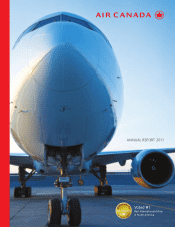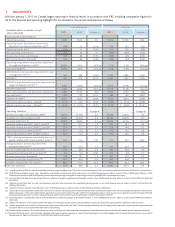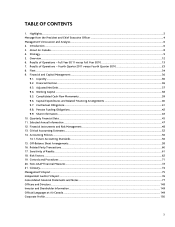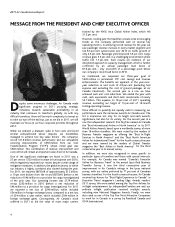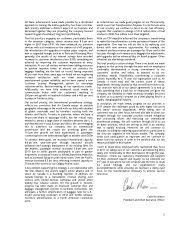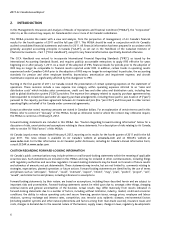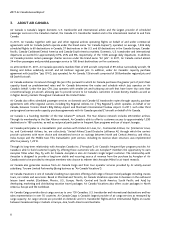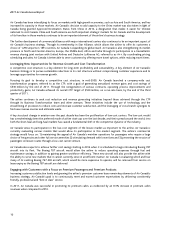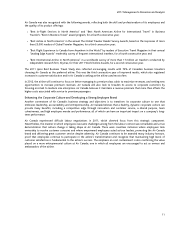Air Canada 2011 Annual Report Download - page 9
Download and view the complete annual report
Please find page 9 of the 2011 Air Canada annual report below. You can navigate through the pages in the report by either clicking on the pages listed below, or by using the keyword search tool below to find specific information within the annual report.2011 Management’s Discussion and Analysis
9
4. STRATEGY
Air Canada has been pursuing a strategy of profitable growth and sustainability to create value for shareholders and to lower
the overall risk profile of the company. The airline continues to focus its activities on improving its revenue performance while
increasing its productivity and improving its cost structure with the objective of increasing operating earnings and cash flow.
Key components of this strategy are to leverage Air Canada’s strengths internationally, reduce costs and generate incremental
revenues; profitably provide “best in class” customer services and products, with particular focus on the business traveller, and
to transform Air Canada’s corporate culture with an emphasis on leadership, accountability and entrepreneurship. Air Canada’s
goal is to enhance its position as one of the world’s leading international carriers.
Leveraging the International Network
In 2010, in anticipation of growing demand for international passenger travel, Air Canada focused on progressively expanding
its services in selected international markets while moderating growth in the domestic market. In 2010, capacity in the
international markets (including U.S. transborder) increased 10.0%. In 2011, when compared to 2010, capacity growth of
6.6% in international markets (including U.S. transborder) reflected the full year impact of this initiative.
In 2012, Air Canada’s focus is to continue leveraging its international network while maintaining a disciplined approach to
growth. Air Canada believes it is well positioned to increase its international market by leveraging the following competitive
advantages:
Its widely-recognized brand and its strong position in the market for transatlantic and transpacific travel to and from
Canada and the Canada-South America market;
Its extensive global network, which is enhanced by Air Canada’s membership in Star Alliance and by its participation in a
transatlantic revenue sharing joint venture;
Its young fleet, with an average age of 11.6 years at December 31, 2011 (average age of widebody aircraft of 12.3 years);
Its Aeroplan program, which was voted “Program of the Year in the Americas” at the 2011 Frequent Travelers Awards;
Its competitive products and services, including lie-flat beds in the Executive First cabin, concierge services and Maple
Leaf lounges; and
Its geographically well-positioned hubs (Toronto, Montreal and Vancouver), which provide natural advantages to serve
customers travelling to or from the U.S. to Asia and Europe.
Through its world-class hub at Toronto Pearson International Airport (“Toronto Pearson”) and strong international gateways
at Montreal and Vancouver, Air Canada intends to grow global connecting traffic via Canada.
With its proximity to densely populated markets and superior facilities, Toronto Pearson provides a clear advantage, on which
Air Canada intends to capitalize. Air Canada is working closely with the Greater Toronto Airport Authority (“GTAA”) to
continue to transform Toronto Pearson into a leading North American airport for international connections. With the
consolidation of Air Canada’s and most of its Star Alliance partners’ operations in one terminal, Toronto Pearson’s in-transit
facilities now allow passengers to move seamlessly between Canada and U.S. Customs and Immigration.
Air Canada plans to continue to leverage its competitive advantages to capture sixth freedom traffic from the U.S. (meaning
U.S. originating traffic carried through points in Canada to other international destinations), particularly from the Eastern U.S.
where consumers are already in the habit of connecting to international flights. With its 54% share of passenger traffic at
Toronto Pearson, Air Canada has the critical mass needed to attract a large share of traffic between the U.S. and Europe, Asia
and Africa. Air Canada currently flies to 50 U.S. destinations from Toronto Pearson, including San Diego, Portland (Oregon),
Cincinnati, Memphis, Portland (Maine), Syracuse (New York) and New Orleans, which were all added in 2010.
Air Canada believes that the significant increase in passenger flow that is now travelling from the United States and choosing
to connect through the airline’s hub airports in Canada to onward international flights is evidence that Air Canada’s efforts are
yielding results. While all hubs are experiencing connection growth, Toronto Pearson has experienced the highest increase in
international connecting traffic with an increase of 110% since 2009.

